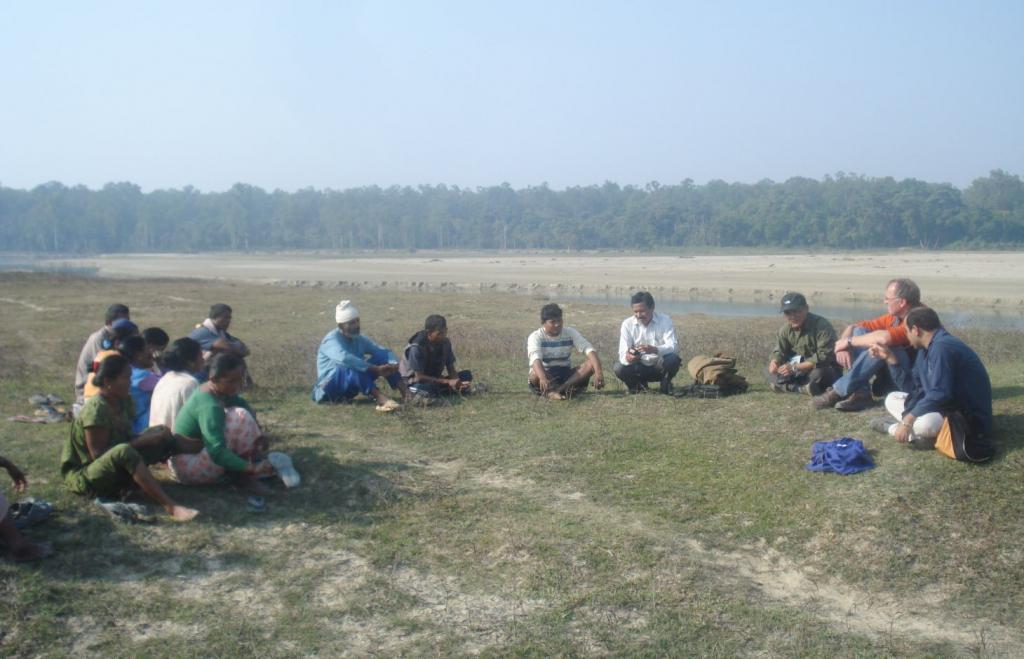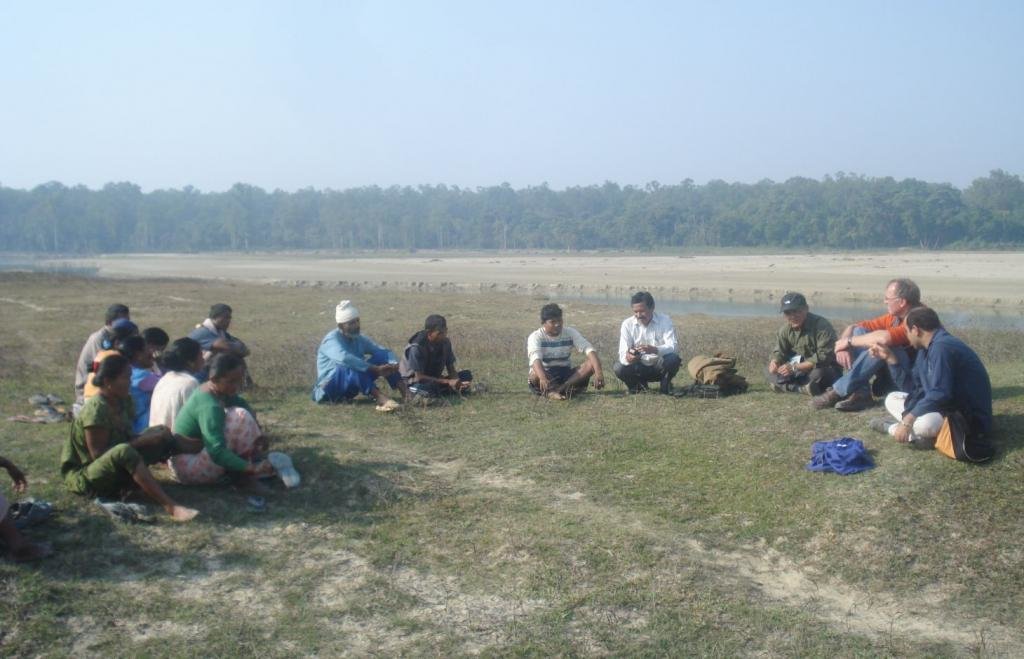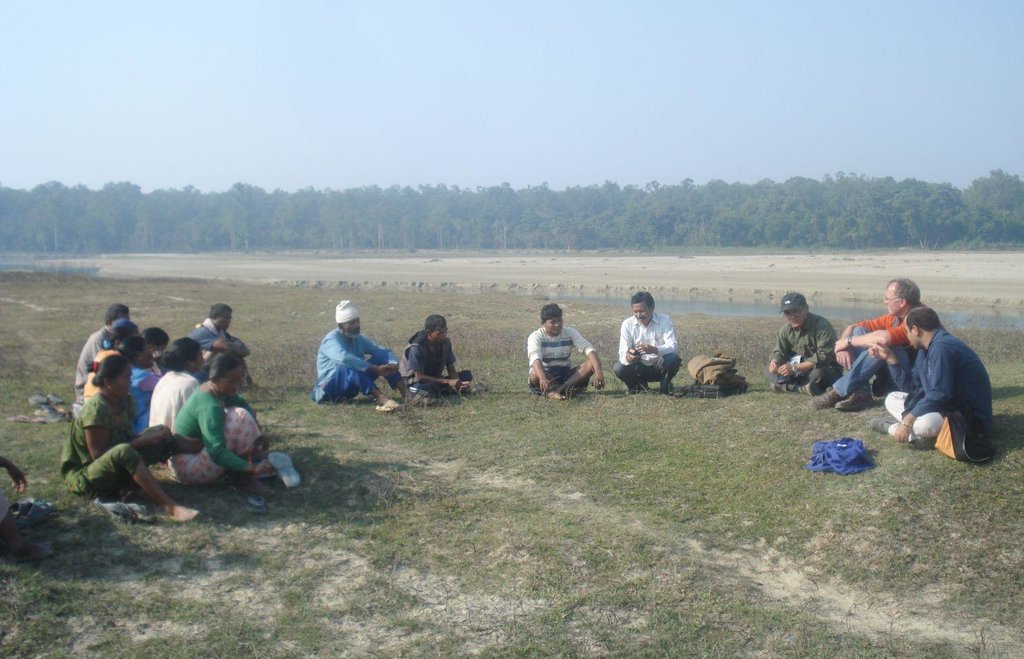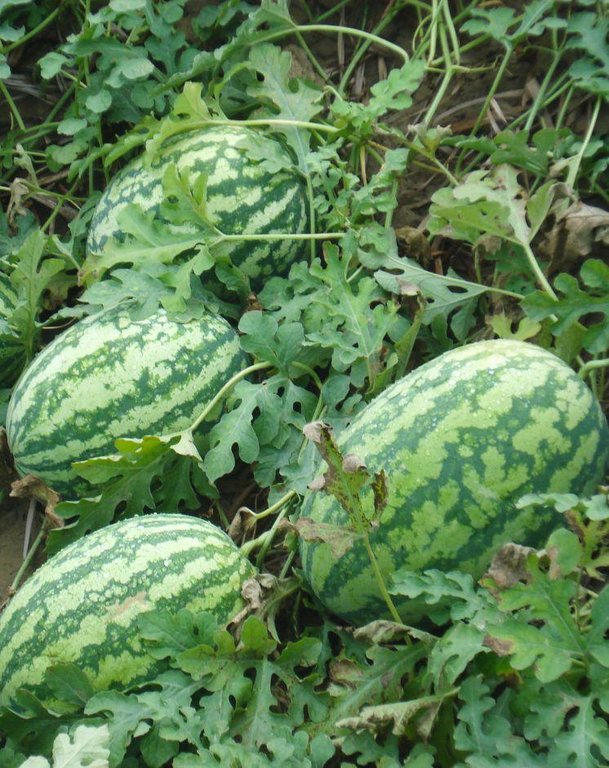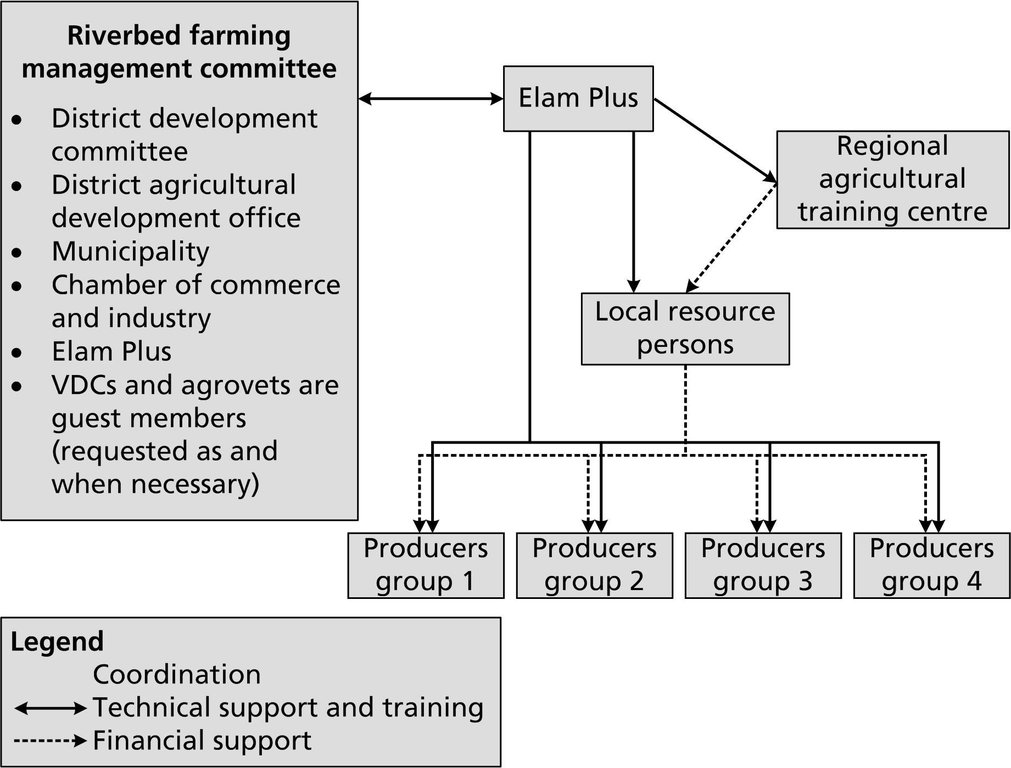Land distribution and allocation for riverbed farming [ប្រទេសនេប៉ាល់]
- ការបង្កើត៖
- បច្ចុប្បន្នភាព
- អ្នកចងក្រង៖ Shreedip Sigdel
- អ្នកកែសម្រួល៖ –
- អ្នកត្រួតពិនិត្យ Fabian Ottiger
Bagare Kheti ko lagi bhumi bitaran ra bhibhajan (Main Contributor: Juerg Merz & Hari Gurung, HELVETAS)
approaches_2534 - ប្រទេសនេប៉ាល់
ពិនិត្យមើលគ្រប់ផ្នែក
ពង្រីកមើលទាំងអស់ បង្រួមទាំងអស់1. ព័ត៌មានទូទៅ
1.2 ព័ត៌មានលម្អិតពីបុគ្គលសំខាន់ៗ និងស្ថាប័នដែលចូលរួមក្នុងការវាយតម្លៃ និងចងក្រងឯកសារនៃវិធីសាស្ត្រផ្សព្វផ្សាយ
អ្នកជំនាញឯកទេស SLM:
Merz Jürg
+977 1 5524925; +977 985104442 (M)
juerg.merz@helvetas.org.np
HELVETAS Swiss Intercooperation Nepal
ប្រទេសស្វ៊ីស
អ្នកជំនាញឯកទេស SLM:
Gurung Hari
+9741056444 (M)
hari.gurung@helvetas.org.np
HELVETAS Swiss Intercooperation Nepal
ប្រទេសនេប៉ាល់
ឈ្មោះអង្គភាពមួយ (ច្រើន) ដែលបានចងក្រងឯកសារ/ វាយតម្លៃលើវិធីសាស្ត្រផ្សព្វផ្សាយ (បើទាក់ទង)
HELVETAS (Swiss Intercooperation)ឈ្មោះអង្គភាពមួយ (ច្រើន) ដែលបានចងក្រងឯកសារ/ វាយតម្លៃលើវិធីសាស្ត្រផ្សព្វផ្សាយ (បើទាក់ទង)
ICIMOD International Centre for Integrated Mountain Development (ICIMOD) - ប្រទេសនេប៉ាល់1.3 លក្ខខណ្ឌទាក់ទងទៅនឹងការប្រើប្រាស់ទិន្នន័យដែលបានចងក្រងតាមរយៈវ៉ូខេត
តើពេលណាដែលទិន្នន័យបានចងក្រង (នៅទីវាល)?
01/03/2013
អ្នកចងក្រង និង(បុគ្គលសំខាន់ៗ)យល់ព្រមទទួលយកនូវលក្ខខណ្ឌនានាទាក់ទងទៅនឹងការប្រើប្រាស់ទិន្នន័យដែលបានចងក្រងតាមរយៈ វ៉ូខេត:
បាទ/ចា៎
1.4 ការយោងមួយ (ច្រើន) ទៅលើ (កម្រង) បញ្ជីសំណួរនៃបច្ចេកទេស SLM
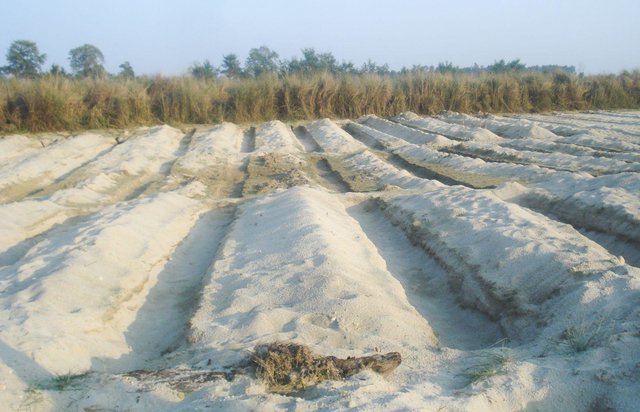
Riverbed farming [ប្រទេសនេប៉ាល់]
Riverbed farming can be used to increase household income and to improve the food security of landless and land-poor households in the Terai area of Nepal.
- អ្នកចងក្រង៖ Shreedip Sigdel
2. ការពណ៌នាអំពីវិធីសាស្ត្រផ្សព្វផ្សាយ SLM
2.1 ពណ៌នាសង្ខេបខ្លីពីវិធីសាស្ត្រផ្សព្វផ្សាយ
Riverbed farming provides landless and land-poor households with the possibility to earn an income from on-farm activities close to home
2.2 ពណ៌នាលម្អិតពិវិធីសាស្ត្រផ្សព្វផ្សាយ
ពណ៌នាលម្អិតពិវិធីសាស្ត្រផ្សព្វផ្សាយ:
Aims / objectives: At least 20% of the households in the Terai, the plains of southern Nepal, do not own land. In order to make a living, these households commonly rely on share cropping and work in low paid off-farm jobs. The approach described here allows these farmers to make the most of the large areas of fallow land near riverbeds which are normally unclaimed and not cultivated. Since the lands near riverbeds have alluvial soils and sufficient moisture, they are suitable for seasonal vegetable cultivation during the dry season. In order for these landless and land-poor households to be able to farm these riverbed areas, they need to have access to suitable plots and the necessary agricultural inputs and training.
Methods: Potential riverbed areas are identified using topographic maps; subsequently, field verification identifies whether the selected riverbed areas are indeed suitable for cultivating horticultural crops. During the field verification, target groups in the given riverbed area are identified and the land is assessed in consultation with them. The relevant stakeholders are the village development committee and the district agricultural development office. Local resource persons are selected from target groups, which typically consist of 20 to 25 households, and are given training so that they can provide the local technical support. Once the farmer target groups have been identified and the riverbed sites selected, the group is given the legal support needed to get a leasehold agreement with the land owner, often the state. The riverbed area is then parcelled out to landless and land-poor households based on fixed selection criteria. This approach works best when the riverbed land area is at least 3 ha because it means that every target household can cultivate at least 0.13 ha (4 kattha), the least amount of land which can provide a meaningful cash income.
2.3 រូបភាពនៃវិធីសាស្ត្រផ្សព្វផ្សាយ
2.5 ប្រទេស/តំបន់/ទីតាំងកន្លែង ដែលវិធីសាស្ត្រផ្សព្វផ្សាយត្រូវបានអនុវត្តន៍
ប្រទេស:
ប្រទេសនេប៉ាល់
បញ្ជាក់បន្ថែមពីលក្ខណៈនៃទីតាំង:
Kanchanpur and Kailali District
2.7 ប្រភេទនៃវិធីសាស្ត្រផ្សព្វផ្សាយ
- ផ្អែកលើគម្រោង/កម្មវិធី
2.8 គោលបំណង/ទិសដៅសំខាន់នៃវិធីសាស្ត្រផ្សព្វផ្សាយ
The Approach focused mainly on SLM with other activities (income generation of poor and landless household)
Give landless and land-poor households access to riverbed land for cash crop cultivation so that they can increase their household income and their food security
The SLM Approach addressed the following problems: • A high number of landless and land-poor households subsist on share cropping and low paid off-farm work
• The number of landless and land-poor households is increasing because many farmers have lost their agricultural land due to floods, many hill farmers are migrating to the Terai, and an increasing population means that holdings are divided up into ever smaller plots
• Inadequate agricultural extension for riverbed farming
• There are no local level policies which allow landless and land-poor farmers access to marginal lands
2.9 លក្ខខណ្ឌអនុញ្ញាត ឬរារាំងការអនុវត្តន៍បច្ចេកទេសដែលស្ថិតនៅក្រោមវិធីសាស្រ្តផ្សព្វផ្សាយ
បរិបទនៃស្ថាប័ន
- រារាំង
The government's extension service does not cover riverbed farming
Treatment through the SLM Approach: Local resource persons are trained and mobilized to provide agricultural extension services to riverbed farmers.
ក្របខណ្ឌច្បាប់ (សិទ្ធិកាន់កាប់ដីធ្លី កម្មសិទ្ធីប្រើប្រាស់ដីនិងទឹក)
- រារាំង
Riverbeds are generally owned by the state (village development committee, municipality, or community forest users' groups) and in some cases, by private owners. The owners are reluctant to provide access to the riverbed land because of the Tenant Law. About 65% of the riverbed land is owned by the state and the rest is privately owned. Individual land right issues are discussed in the group and negotiated among group members. Generally, the choice of crops for riverbed farming depends on the type of soil and the sand moisture level; attempts are made to minimize the amount of river water used. So far, downstream farmers have not complained about any overuse of water by upstream riverbed farmers. In this regard, water rights issues are not generally raised.
Treatment through the SLM Approach: Farmers and land owners agree on a 3-year lease for riverbed land. The land is allocated according to the size of the group, the size of the land, and its location relative to the river. Each member is allocated 4 katthas (0.13 ha) perpendicular to the river flow.
A border is determined and the area is guarded at night.
ចំណេះដឹងស្តីពី SLM និងការទទួលបានការគាំទ្រផ្នែកបច្ចេកទេស
- រារាំង
Seeds for crops which are suitable for riverbed farming generally come from India and the local agrovets often cannot supply them on time.
Treatment through the SLM Approach: Agrovets are informed about the type of agricultural inputs needed (seeds, fertilizers, bio-pesticides) and how to supply them. Riverbed farmers are trained on how to use local and improved seeds and how to conserve and store them.
ផ្សេងៗ
- រារាំង
Unclear government policies may limit access to riverbed land and subsidies from poverty alleviation programmes
Treatment through the SLM Approach: Lobby local bodies to address issues of riverbed farming policies
3. ការចូលរួម និងតួនាទីរបស់ភាគីពាក់ព័ន្ធ
3.1 អ្នកពាក់ព័ន្ធដែលបានចូលរួមក្នុងវិធីសាស្ត្រផ្សព្វផ្សាយ និងតួនាទីរបស់ពួកគេ
- អ្នកប្រើប្រាស់ដីក្នុងតំបន់/សហគមន៍
- អ្នកឯកទេសគ្រប់គ្រងដីប្រកបដោយចីរភាព/ទីប្រឹក្សាបច្ចេកទេសកសិកម្ម
- អង្គការក្រៅរដ្ឋាភិបាល
Elam Plus
- រដ្ឋាភិបាលថ្នាក់ជាតិ (អ្នករៀបចំផែនការ អ្នកសម្រេចចិត្ត)
3.2 ការចូលរួមរបស់អ្នកប្រើប្រាស់ដីក្នុងតំបន់/ សហគមន៍ក្នុងតំបន់ក្នុងដំណាក់កាលផ្សេងគ្នានៃវិធីសាស្រ្តផ្សព្វផ្សាយ
| ការចូលរួមរបស់អ្នកប្រើប្រាស់ដីក្នុងតំបន់/សហគមន៍ក្នុងតំបន់ | សូមបញ្ជាក់នរណាត្រូវបានចូលរួម ព្រមទាំងពណ៌នាសកម្មភាពទាំងនោះ | |
|---|---|---|
| ការចាប់ផ្តើម/ការលើកទឹកចិត្ត | អន្តរកម្ម | Group meeting conducted with key members of a group, request for follow-up forwarded to supporting organization. |
| ការរៀបចំផែនការ | អន្តរកម្ម | The riverbed area is selected and the land is distributed to the members. The arrangements are agreed in consultation with both men and women of the producer group. |
| ការអនុវត្តន៍ | គំនិតផ្តួចផ្តើមដោយខ្ឡួនឯង | Land preparation, sowing, irrigation, weeding, harvesting, and marketing. Both men and women are involved. |
| ការត្រួតពិនិត្យ និងវាយតម្លៃ | អន្តរកម្ម | The process of requesting access to the riverbed land involves group level discussions between farmers and government officials or land owners. Key members of the group (e.g. chair person or secretary) are involved in monitoring and evaluating the success of the riverbed farming programme. |
| Research | អន្តរកម្ម | Farmers pilot crop innovations based on the research design suggested by supporting organizations and they provide feedback on how successful the implementation was. |
3.3 គំនូសបំព្រួញ (ប្រសិនបើមាន)
ការពណ៌នា:
committee:
• Organize, review, and plan meetings
• Decide on suppliers
• Oversee the land lease process and insure that the land is properly allocated
• Conduct field monitoring
Role of Elam Plus:
• Organize stakeholders' meetings for managing and generating resources
• Funding support
• Introduce innovations
• Train local resource persons
Role of local resource persons:
• Provide technical support to farmers
• Support producers groups to maintain records and bookkeeping
• Support producers groups to find market linkages
Role of Regional Agricultural Training Centre:
• Develop modular training package
• Train local resource persons
(AK Thaku)
3.4 ការសម្រេចចិត្តលើការជ្រើសរើសបច្ចេកទេស SLM
សូមបញ្ជាក់តើអ្នកណាជាអ្នកបានសម្រេចចិត្តក្នុងការជ្រើសរើសបច្ចេកទេសដើម្បីយកមកអនុវត្តន៍:
- អ្នកប្រើប្រាស់ដី ដោយមានការគាំទ្រពីអ្នកជំនាញឯកទេស SLM
ចូរពន្យល់:
Farm coordinators consult with the Elam Plus team, the District Agricultural Development Office, local resource persons, and producers groups to come up with a mutually agreed technology.
Decisions on the method of implementing the SLM Technology were made by mainly by land users supported by SLM specialists. Producers groups and local resource persons work in close collaboration with farm coordinators and the enterprise development officers of Elam Plus.
4. ជំនួយបច្ចេកទេស ការកសាងសមត្ថភាព និងការគ្រប់គ្រងចំណេះដឹង
4.1 ការកសាងសមត្ថភាព/ បណ្តុះបណ្តាល
តើវគ្គបណ្តុះបណ្តាលបានផ្តល់ឱ្យអ្នកប្រើប្រាស់ដី/អ្នកពាក់ព័ន្ធផ្សេងៗទៀតដែរឬទេ?
បាទ/ចា៎
សូមបញ្ជាក់តើអ្នកណាត្រូវបានបណ្តុះបណ្តាល:
- បុគ្គលិកចុះទីវាល/អ្នកផ្តល់ប្រឹក្សាយោបល់
ទម្រង់នៃការបណ្តុះបណ្តាល:
- Technical training and extension services
ប្រធានបទបណ្តុះបណ្តាល:
The Regional Agricultural Training Centre of the Department of Agriculture trains the local resource persons. Once trained, they help to raise awareness among landless and land-poor farmers of the advantages of riverbed farming and they also give them technical training and extension services
4.2 សេវាផ្តល់ប្រឹក្សាយោបល់
តើអ្នកប្រើប្រាស់ដីបានទទួលនូវសេវាផ្តល់ប្រឹក្សាដែរ ឬទេ?
បាទ/ចា៎
សូមបញ្ជាក់ប្រសិនបើសេវាកម្មប្រឹក្សាយោបល់ត្រូវបានផ្តល់ឱ្យ:
- នៅលើដីរបស់អ្នកប្រើប្រាស់ដី
ពណ៌នា/ពន្យល់:
Name of method used for advisory service: Training; Key elements: The District Agricultural Development Office provides plant protection expertise and Elam Plus provides technical backstopping and field learning.
4.3 ការពង្រឹងសមត្ថភាពស្ថាប័ន (ការអភិរឌ្ឍន៍អង្គភាព)
តើស្ថាប័នទាំងអស់ត្រូវបានបង្កើតឡើង ឬពង្រឹងសមត្ថភាពតាមរយៈវិធីសាស្ត្រផ្សព្វផ្សាយដែរ ឬទេ?
- បាទ/ច៎ា ជាមធ្យម
សូមបញ្ជាក់ថាតើស្ថាប័នត្រូវបានពង្រឹង ឬបង្កើតឡើងនៅត្រឹមកម្រិតណា(ច្រើន)?
- ថ្នាក់មូលដ្ឋាន
សូមបញ្ជាក់ប្រភេទនៃការគាំទ្រ:
- ការកសាងសមត្ថភាព/ បណ្តុះបណ្តាល
សូមផ្តល់ព័ត៌មានបន្ថែមទៀតឱ្យបានលម្អិត:
Local resource persons form their own organizations and their capacity is strengthened.
4.4 ការត្រួតពិនិត្យ និងវាយតម្លៃ
តើការត្រួតពិនិត្យ និងវាយតម្លៃគឺជាផ្នែកមួយនៃវិធីសាស្ត្រដែរឬទេ?
បាទ/ចា៎
មតិយោបល់:
technical aspects were monitored through measurements; indicators: In total, 35 local resource persons were trained and mobilized in Kailali and Kanchanpur Districts.
socio-cultural aspects were monitored through observations; indicators: Riverbed farming indirectly reduces outmigration and the need for farmers to seek off-farm employment like collecting and cutting fuelwood and other seasonal labour.
economic / production aspects were monitored through measurements; indicators: On average, households can earn USD 352 (NPR 25,000) in 6 months from 0.13 ha (4 katthas) of land.
area treated aspects were monitored through measurements; indicators: In 2011, a total area of 396 ha was under riverbed cultivation with support from Elam Plus in Kailali and Kanchanpur.
no. of land users involved aspects were monitored through measurements; indicators: In 2011, about 3,000 landless and land-poor households were involved in 122 riverbed farming areas. The number of households increased from 2000 in 2008 to 3165 in 2012.
management of Approach aspects were monitored through observations; indicators: Management of the riverbed farming programme is handled by Elam Plus. The riverbed farming management committee plays an active role in co-ordinating fund contributions from stakeholders for input purchases, organizing planning and review meetings, conducting joint field monitoring, and other relate
4.5 ការស្រាវជ្រាវ
តើការស្រាវជ្រាវ គឺជាផ្នែកមួយនៃវិធីសាស្រ្តដែរឬទេ?
បាទ/ចា៎
បញ្ជាក់ប្រធានបទ:
- បច្ចេកវិទ្យា
សូមផ្តល់ព័ត៌មានបន្ថែមទៀតឱ្យបានលម្អិត និងចង្អុលបង្ហាញនរណាដែលបានធ្វើការស្រាវជ្រាវ:
Innovations, such as piloting new crops, selecting appropriate varieties, and trying out new cultivation techniques are activities supported by Elam Plus through regular communication with the local resource persons.
Research was carried out both on station and on-farm
5. ថវិកា និងសម្ភារៈឧបត្ថម្ភពីខាងក្រៅ
5.1 ថវិកាប្រចាំឆ្នាំសម្រាប់ផ្សព្វផ្សាយ SLM
មតិយោបល់ (ឧ. ប្រភពសំខាន់នៃមូលនិធិ/ម្ចាស់ជំនួយចំបង):
Approach costs were met by the following donors: national non-government (Producer's Group): 40.0%; other: 60.0%
5.2 ការគាំទ្រផ្នែកហិរញ្ញវត្ថុ / សម្ភារៈដែលបានផ្តល់ទៅឱ្យអ្នកប្រើប្រាស់ដី
តើអ្នកប្រើប្រាស់ដីបានទទួលការគាំទ្រផ្នែកហិរញ្ញវត្ថ/សម្ភារៈសម្រាប់ការអនុវត្តន៍បច្ចេកទេសដែរឬទេ:
បាទ/ចា៎
5.3 សូមបញ្ជាក់ពីធាតុចូលត្រូវបានផ្តល់បដិភាគ (រួមទាំងកម្លាំងពលកម្ម)
- កសិកម្ម
| សូមបញ្ជាក់ ធាតុចូលណាខ្លះដែលបានផ្តល់បដិភាគ | កម្រិតទំហំប៉ុណ្ណា | សូមបញ្ជាក់ពីការបដិភាគ |
|---|---|---|
| គ្រាប់ពូជ | ផ្តល់ហិរញ្ញវត្ថុមួយផ្នែក | |
- ផ្សេងៗ
| ផ្សេងៗ (បញ្ចាក់) | កម្រិតទំហំប៉ុណ្ណា | សូមបញ្ជាក់ពីការបដិភាគ |
|---|---|---|
| ផ្តល់ហិរញ្ញវត្ថុមួយផ្នែក | In the first year, USD 331 (NPR 23,531) worth of inputs are provided by the supporting organizations. In the second year, only 50% is provided, mainly to cover the cost of the seeds. In the third year, only 50% of the cost for the services of the local resource persons and market linkage support are provided. |
ប្រសិនបើកម្លាំងពលកម្មធ្វើដោយអ្នកប្រើប្រាស់ដី តើវាជាធាតុចូលដ៏សំខាន់មួយដែរ ឬទេ:
- ដោយស្ម័គ្រចិត្ត
មតិយោបល់:
Labour is provided by the farmer groups themselves costing an equivalent of USD 213 (NPR 15,100) per hectare.
5.4 ឥណទាន
តើឥណទានដែលបានផ្តល់នៅក្រោមវិធីសាស្ត្រផ្សព្វផ្សាយសម្រាប់សកម្មភាព SLM នេះយ៉ាងដូចម្តេច?
បាទ/ចា៎
សូមបញ្ជាក់លក្ខខណ្ឌ (អាត្រាការប្រាក់ ការសង ។ល។):
No credit was extended for riverbed farming, but the groups have initiated their own savings schemes. These group funds can be used for loans to purchase the required inputs.
6. ការវិភាគរកផលប៉ះពាល់ និងសេចក្តីសន្និដ្ឋាន
6.1 ផលប៉ះពាល់នៃវិធីសាស្ត្រផ្សព្វផ្សាយ
តើវិធីសាស្ត្រផ្សព្វផ្សាយជួយអ្នកប្រើប្រាស់ដីដើម្បីអនុវត្តន៍ និងថែទាំបច្ចេកទេស SLM?
- ទេ
- បាទ/ច៎ា បន្តិចបន្តួច
- បាទ/ច៎ា ជាមធ្យម
- បាទ/ច៎ា បានខ្លាំង
Previously underutilized land resources are productively used for vegetable production and income generation. When farmers use organic methods, the impact on the river ecology is minimal.
តើវិធីសាស្ត្រផ្សព្វផ្សាយនេះផ្តល់សិទ្ធិអំណាចដល់សង្គមនិងសេដ្ឋកិច្ចដែលក្រុមមិនទទួលបានផលប្រយោជន៍?
- ទេ
- បាទ/ច៎ា បន្តិចបន្តួច
- បាទ/ច៎ា ជាមធ្យម
- បាទ/ច៎ា បានខ្លាំង
The vegetable consumption of disadvantaged groups has improved. In addition, they also earned cash from riverbed farming that they spent to purchase education, health care, and food grain.
Did other land users / projects adopt the Approach?
- ទេ
- បាទ/ច៎ា បន្តិចបន្តួច
- បាទ/ច៎ា ជាមធ្យម
- បាទ/ច៎ា បានខ្លាំង
Other groups and projects have started to replicate riverbed farming in their own areas by imitating what they have observed of groups working with Elam Plus.
Did the Approach lead to improved livelihoods / human well-being?
- ទេ
- បាទ/ច៎ា បន្តិចបន្តួច
- បាទ/ច៎ា ជាមធ្យម
- បាទ/ច៎ា បានខ្លាំង
Households earned on average USD 352, or NPR 25,000, per household from 0.13 ha of land. Locally traded, this is equivalent to four months' worth of additional food grain.
Did the Approach help to alleviate poverty?
- ទេ
- បាទ/ច៎ា បន្តិចបន្តួច
- បាទ/ច៎ា ជាមធ្យម
- បាទ/ច៎ា បានខ្លាំង
Cash income from the sale of riverbed farming produce helped to alleviate poverty to some extent.
6.2 ការលើកទឹកចិត្តចម្បងៗរបស់អ្នកប្រើប្រាស់ដីសម្រាប់ការអនុវត្តបច្ចេកទេស SLM
- បង្កើនផលិតកម្ម
- well-being and livelihoods improvement
6.3 សកម្មភាពផ្សព្វផ្សាយដែលប្រកបដោយចីរភាព
តើអ្នកប្រើប្រាស់ដីអាចធ្វើឱ្យមានចីរភាពនូវអ្វីដែលត្រូវបានអនុវត្តន៍តាមរយៈវិធីសាស្ត្រផ្សព្វផ្សាយដែរឬទេ(ដោយពុំមានការគាំទ្រពីអ្នកខាងក្រៅ)?
- បាទ/ចា៎
ប្រសិនបាទ/ច៎ា សូមរៀបរាប់ថាធ្វើយ៉ាងម៉េច:
The local stakeholders in the riverbed farming approach are committed to providing funds and to being actively involved in reviews, planning, and joint field monitoring. Riverbed farmers have gained basic know-how, and trained local resource persons are available to help at the local level if needed. The Micro Enterprise Development Fund now has a presence in the district and producers can access support from them for riverbed farming. Farmers' groups have already organized savings schemes that can be used to purchase the required agricultural inputs. The majority of farmers continued riverbed farming beyond the third crop and many made a significant income. Riverbed farming has a negligible negative impact on the environment. When all of these factors are considered, riverbed farming is indeed a sustainable activity.
6.4 ភាពខ្លាំង/ គុណសម្បត្តិនៃវិធីសាស្ត្រផ្សព្វផ្សាយ
| ភាពខ្លាំង/ គុណសម្បត្តិ/ ឱកាស ទស្សនៈរបស់បុគ្គលសំខាន់ៗ |
|---|
| Marketing facilitators have been developed in each group. (How to sustain/ enhance this strength: Capacity building of the marketing facilitators needs further attention.) |
| Local agrovets are available and they have the capacity to provide the right inputs. (How to sustain/ enhance this strength: Local agrovets need to be aware of the needs of this new type of farming in order to ensure timely inputs.) |
| Local government stakeholders are positive about riverbed farming and the current level of coordination from Elam Plus is appreciated. (How to sustain/ enhance this strength: This needs a model so that it can be institutionalized and replicated in other areas.) |
| Trained resource persons who can provide extension services are available locally. (How to sustain/ enhance this strength: The local resource persons need to be linked with the Micro Enterprise Development Fund and their services need to be diversified to include aspects all along the market chain.) |
| Groups have mobilized their savings funds to purchase inputs. (How to sustain/ enhance this strength: Encourage the formation of savings and credit groups.) |
| Riverbed farming increases household income. (How to sustain/ enhance this strength: Market-led production should be further promoted.) |
| Village development committees have to become involved in the land leasing process. (How to sustain/ enhance this strength: Develop policies related to land leasing.) |
6.5 ភាពខ្សោយ/ គុណវិបត្តិនៃវិធីសាស្ត្រ និងរកដំណោះស្រាយ
| ភាពខ្សោយ/ គុណវិបត្តិ/ ហានិភ័យក្នុងទស្សនៈរបស់បុគ្គលសំខាន់ៗ | តើបច្ចេកទេសទាំងនោះបានដោះស្រាយបញ្ហាដូចម្តេច? |
|---|---|
| Currently riverbed farming producer groups are scattered and their production is limited. | Production needs be market-led and farmers should have better links to markets. |
| Riverbed farming is supported on a case-to-case basis by line agencies and non-governmental organizations. | The Ministry of Local Development can develop a riverbed farming policy to ensure that landless and land-poor farmers have access to riverbed lands |
7. ឯកសារយោង និងវេបសាយ
7.1 វិធីសាស្ត្រ/ ប្រភពនៃព័ត៌មាន
- តាមការចុះទីវាល ការស្រាវជ្រាវនៅទីវាល
- ការសម្ភាសន៍ជាមួយអ្នកប្រើប្រាស់ដី
ការតភ្ជាប់ និងម៉ូឌុល
ពង្រីកមើលទាំងអស់ បង្រួមទាំងអស់ការតភ្ជាប់

Riverbed farming [ប្រទេសនេប៉ាល់]
Riverbed farming can be used to increase household income and to improve the food security of landless and land-poor households in the Terai area of Nepal.
- អ្នកចងក្រង៖ Shreedip Sigdel
ម៉ូឌុល
គ្មានម៉ូឌុល


